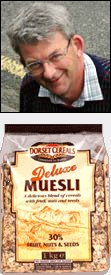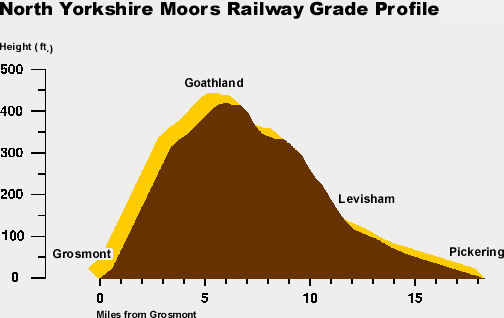










There's a sleepy little Yorkshire village in England named Grosmont that lies at the junction of Britain's mainline railways and a steam line known as the North Yorkshire Moors Railway. With limited accommodation at Grosmont most tourists opt to stay at the southern end of the NYMR in Pickering where there are more choices. But then they would miss Hazelwood House B&B on Grosmont's Front Street. From the front room you can hear, see, and smell the steam engines just up the road. Breakfast is served in the lower conservatory, or tea room, and includes amongst many delicious items, what the proprietor calls Budgie Grit, or Muesli. Really, it tastes nothing like his unflattering moniker, and it has the added bonus of adding to a healthy breakfast. What with all the walking about taking steam locomotive photos a good breakfast is appreciated.
In 1836 a 24 mile line from Pickering to Grosmont onto Whitby on the North Sea was completed at a cost of £130,000.
Initially the line operated horse-drawn carriages. Steam locomotives were introduced in 1845 along with many improvements including new bridges and a tunnel.
As part of the Beeching Plan , which closed many rural lines, in 1965 the Pickering-Grosmont-Whitby line was terminated after 130 years of service to the people of Yorkshire. There was a huge public outcry at the closure followed by a wave of support for the Yorkshire Moors Railway Preservation Society.
, which closed many rural lines, in 1965 the Pickering-Grosmont-Whitby line was terminated after 130 years of service to the people of Yorkshire. There was a huge public outcry at the closure followed by a wave of support for the Yorkshire Moors Railway Preservation Society.
A newly formed British Rail sold the first section of track to that society in 1968. The society was eventually replaced by the North York Moors Historical Railway Trust. Eight years after closure the North Yorkshire Moors Railway opened for business between Pickering and Grosmont on 1 May 1973.
To see a steam engine operating is interesting but to see a steam engine working under load on a stiff grade is a glorious sight to behold. The grade between Grosmont and Goathland, known as the "bank", is measured as 1 in 49. In North American terms this equates to just over 2 percent. To me this is one of the North Yorkshire Moors' main attractions. The ability to show off steam working at grade. There are not too many places in England where locomotives tackle this steep a bank.

Lets begin our tour of this line at Grosmont, travel south to Pickering, then return to Grosmont to put a steam engine to bed for the night. All photos were taken by riding the trains and walking to various locations along the line.
The NYMR station at Grosmont is located directly across the parking lot from Network Rail's mainline railway station. Three tracks of the NYMR cross Front Street of Grosmont village with the crossing protected by wooden swing gates controlled from an gate and signal tower. A water standpipe is located at the north end of the platform for watering their steam locomotives.
Trains departing south immediately cross the small stream, Murk Esk, then enter a tunnel through a small hill which overlooks the village. The NYMR locomotive shop and engine servicing facilities are located on the south side of this hill. From Grosmont it is a short walk through a parallel pedestrian tunnel to visit the shops. Alternately, there is a foot path leading over the hill. The path parallels the tracks above and to the south where there are opportunities for photographs. I did not explore the full length of the footpath but you can continue for many miles south all the way to Goathland. The path's value lies in its access to the Murk Esk River Valley where you may witness the engines working upgrade on the 2 percent climb to Goathland.
After my pronunciation fiasco at the Keighley & Worth Valley I'm afraid to pronounce the name of this village. Is it GOATland or GOATHland? Photos taken further south of Grosmont were obtained by riding the trains and walking short distances. At Goathland another foot path away from the station to the east climbs a hill which looks down over a wide grassy valley through which the railway route curves over a small bridge. This is a great place to photograph trains.
Goathland itself is a very busy location along the route. Nestled against a hill trains climb southbound to reach the level ground of the station area. The station is constructed of stone and services one track of four. Crossing the pedestrian overbridge you may reach the gift shop and restrooms on the opposite platform. A stub siding holds several passenger cars which may be rented for accommodation. A few freight wagons rest on the other siding by the signal box. A water tank supplies water to a locomotive standpipe at the south end of the platform.
It is common for north and southbound trains to meet here while the token is passed to the signalman, or leverman, from the interlocking box at the south end of the main platform. Token or staff working of this line is carried out to guarantee only one train may occupy a block at one time. This old tried and true method may still be seen in operation on many tourist lines in Britain.
Progressing further south the railway twists and turns as it traverses several wild unoccupied valleys passing through the North York Moors National Park.
Pickering is ancient market town of North Yorkshire lying on the border of the National Park. This medieval town is very much larger than Grosmont and contains many small shops lining the high street, just a short walk from the station. Locomotives run around their carriages here for the return journey to Grosmont while only minimal servicing may be performed.
Daily engine steam-up, steam-down, clean-out, and coaling takes place at the locomotive servicing facility on the south side of Grosmont hill. A large steel coal tower is used to fuel the engines. On one particular day British Railways tank engine number 6619 worked the line dawn to dusk. By the last trip of the day its smokebox was full of cinders. Surely this must have degraded its performance. A front-end loader was brought up to the smokebox and the still hot cinders were hand-shovelled by fireman Geoff Empson into the bucket of the front-end loader. He then dropped the glowing firebox ashes and proceeded under the loco to wet them down using a hose. A rather dangerous job if you ask me. He wore no protection except a long orange cloth coat and was without safety goggles. Steam and smoke were everywhere when the ashes were doused with the water hose. As he explained, that's the way they did it in the old days, and that's the way it's still done today. Yeah, OK...
The day ended with a short walk back to Front Street in Grosmont where the only place to obtain supper was the local pub. The Station Tavern which opened at 19:00 hours prepared a fine dinner. After a hard day's work on the footplate both driver John Walker and fireman Geoff Empson headed to the pub for a pint and supper. Judging from the day-long effort they put forth they earned it.
which opened at 19:00 hours prepared a fine dinner. After a hard day's work on the footplate both driver John Walker and fireman Geoff Empson headed to the pub for a pint and supper. Judging from the day-long effort they put forth they earned it.